
Grand Theft Auto III
Written by: Rik
Date posted: May 12, 2019
- Genre: Action
- Developed by: Rockstar Games
- Published by: Rockstar Games
- Year released: 2002
- Our score: 8
Being on the older and more out of touch end of the gaming spectrum means that I’m not exactly down with what open-world games the kids are playing these days, but I did recently chance upon a relatively recent effort in the digital library and thought, for once: well you did buy this, Rik, so why not play it. It wasn’t long, though, before my mind soon turned to Grand Theft Auto III, arguably the modern prototype for the genre, and I swiftly abandoned what I was playing in favour of giving the series’ first foray into 3D another go.
As you may establish from reading some distant and half-hearted write-ups from many years ago, the first two GTA games held limited appeal for me: the original was good fun to mess around with, but playing properly was hard, with driving and navigating tricky at best, and combat even more fiddly and less forgiving. The sequel, meanwhile, seemed to focus on the wrong things, notably moving away from the recognisable and contemporary setting and placing an emphasis on rather silly and cartoonish gang warfare.
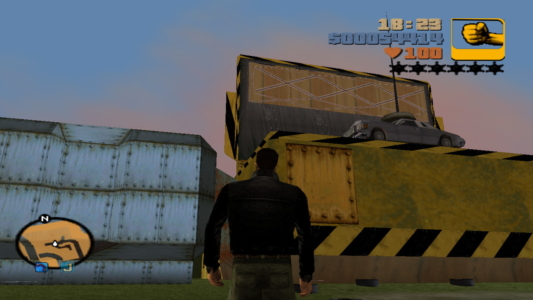
Taking care of business. [What business?] The, er, business of watching a car get crushed, of course.
Clearly, there’s no mystery as to whether Rockstar’s endeavours resulted in success or failure: GTA III is one of the most famous, best-selling and notorious games in recent history. It was released around the same time as this site started, and at that time would have been an example of exactly the kind of modern game that did not need more people writing about it. (Even I managed to stop playing Pro Evolution Soccer for long enough to pick up a copy and make some progress – although not all the way to the end).
For that reason, even though we’ve since covered much more recent titles, it still seems slightly wrong to be adding a review. But, it’s as old as we are (and we’re pretty old), GTA has since moved on to even bigger and better things, and we’ve also now had all of the aforementioned other games and series that GTA III arguably inspired: Saints Row, Assassin’s Creed, Sleeping Dogs, Watch Dogs and Nintendogs [are you sure about that last one? – FFG reader]. So I think we can give ourselves a break in terms of looking at this one now.
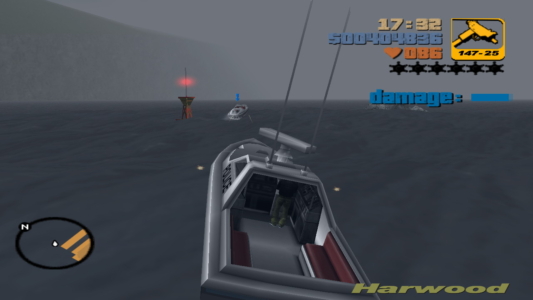
There are numerous ways to get around Liberty, including by boat. Here though we’re on a mission that involves shooting someone.
It’s clear from the outset that GTA III has greater ambitions in terms of storytelling than its predecessors, with a cinematic opening that shows your mute protagonist being betrayed and left for dead by his partner before seguing into an introductory mission in which your character’s journey to a lengthy spell behind bars is interrupted in a manner which provides an opportunity to escape. I loved everything about this first mission when I first played: the choice to give more context to the action by providing a story; the gentle introductory quest; the immediate sense that the driving model was spot on (and a chance to test drive the Kuruma – the equivalent of GTA’s Mundano, the dull but effective family saloon); and most importantly, the blessed relief upon arrival at a safe house and the realisation that, yes – finally – a GTA game was going to allow you to save at virtually any point (the first two games being stubborn in their insistence that you successfully battled through large chunks of the action before allowing you any respite, with so many opportunities to mess things up for yourself along the way).
For me, that introduction said: look, this time we’re going to be clear about what you’re doing and why. There are going to be missions, tasks that will be explained to you beforehand, and you are going to make progress by doing them. There will be other stuff along the way, but there are going to be missions, and when you’ve finished one, you can save your game. All of which made the series a significantly more interesting proposition than it had been previously.
That’s not to say that GTA III is totally linear, or that it’s lacking in the free-wheeling anarchic spirit that made the original game so popular, and there’s lots of potential for exploration and messing around. While the missions sit patiently on your mini-map, to be undertaken at a time of your choosing, you can take a trip around Liberty City (the worst place on earth, as the game’s packaging would have it), although in the first instance, you’re limited to Portland, the first of three islands that make up Liberty (in a clever move, the hijacking of the prison truck during the aforementioned escape takes place on one of the city’s bridges, rendering it unavailable until you unlock the second island, Staunton, through progress via the story missions). To the excitable eyes of a newcomer, it seems that almost anything is possible. And that’s the real trick of the game, because in reality your options are pretty limited: outside of the story missions and ‘side’ missions accessed, as in the original, by answering a ringing payphone.
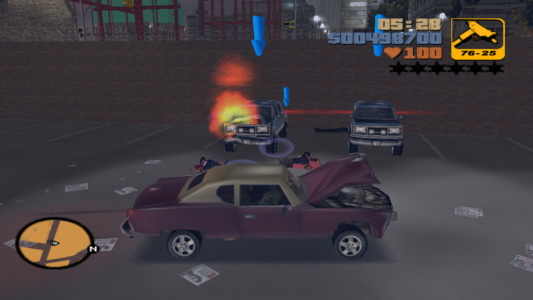
You can execute a drive-by shooting with the uzi. (Although if you’re anything like me driving and shooting at the same time might be beyond you).
One option involves carjacking a service vehicle, which provides for some reliable fun, whether it’s picking up taxi fares, putting out fires, or getting injured people to hospital. Personally I particularly enjoyed Import/Export, in which you have to seek out, steal and deliver a list of stolen vehicles, partly because it’s true to the name of the game, and also because I’ve always been an admirer of the range of cars and vehicles in GTA, from the way each has a distinctive appearance and handling, to the way Rockstar really captures the thrill of driving even a fairly average car quite quickly and recklessly. I also have an instinctive desire to protect and store the speedy and fragile sports cars, even though the nature of the game means they’re not as rare as they seem and are in fact endlessly regenerating (with one notable exception, in my experience – see Finding Mr Whoopee for more), rendering such a strategy pointless. The cars and other vehicles are meant to be disposable, and, indeed, the first time I played the game back in the day, a significant amount of mileage was gleaned from simply driving like a madman, flipping cars over, clambering out of the wreckage and then watching as they set alight and then exploded.
But, as a 37-year-old man rapidly losing any sense of fun or frivolity in favour of meticulously completing lists of tasks set by a third party, the time for messing about in such a way has long since passed, and with a renewed sense of focus, I set about finishing this game I first started playing the best part of 20 years ago. And the way to do that is by getting stuck into the missions.
The structure is fairly simple. At any moment you’ll be able to see one or more ‘story’ missions highlighted on the mini map. Most of the time, it’ll just be one, but sometimes there’s a choice, and it’s not an either/or scenario, unless you jump from one to another and never return to the one that you uncovered first, in which case the events of the story may take over and they may subsequently remain forever unavailable. I suppose it’s one way to skip a few missions or mix things up a bit, but you may miss out on some much-needed completion bonuses (paid in cash) along the way. Anyway, find your location and step into the blue light, and a cut scene will play: usually, gang or person A is getting on your boss’s nerves, and so you need to go teach them a lesson by whacking someone or blowing something up. Actually, that’s not entirely fair: there’s a good mixture of missions, both narratively and in terms of what you’re required to do: often involving some killing, yes, but also some following and observing, some chasing, some protecting, and some escaping.
It’s usually pretty clear what has to be done in each case, and the game is pretty good at prompting you with instructions along the way, without over-doing it. If you fail, you can try again by re-loading a previous save (yes!) or by taking control of your slightly chastened crook again at either the police station or hospital, depending on the specific circumstances of your last failure. In most cases, too, the general rules of the open world still apply when you’re on a mission, which means that you can be creative in your approach rather than following a route proscribed by the game. I have to say that in many instances, this did mean running people over in my car like a big coward rather than engaging in gunfights, which I found to be much more dangerous. With the exception of the sniper rifle, most weapons seem to be fairly dangerous in terms of taking on a number of enemies, and at times this sometimes even meant abandoning a car in the middle of a group of enemies and blowing it up to cause damage, rather than targeting enemies individually. The PS2 had an auto-targeting system to mitigate against imprecise joypad controls, which probably helped in close-up firefights (although that wasn’t my recollection), but anyway, here, they’re hard work.
A low-risk strategy is necessary because death is visited upon you all too swiftly, if you’re not careful. While you can get armour (available, in the first instance at least, from your local Ammu-Nation store), it won’t turn you into an invincible bullet sponge, and for the most part, you’re as susceptible to instant death from gunfire and exploding vehicles as your AI enemies. It does mean though that many missions end, either in success or failure, rather quickly, and in the case of the latter, repeating a mission involves repeating rather too much of the build-up, driving from your hideout to the mission point, then possibly to an intermediate point where the mission proper will start. If you’re getting impatient due to a particularly tricky mission, then it’s likely you’ll damage your car, accidentally run over some pedestrians or plough into a police car along the way and mess things up for yourself before you’ve even started, meaning you start your next attempt in an even more agitated state, and so on.
It’s also tempting to say that, driving bits aside, the on-foot segments of GTA III are at times rather like a quite poor third-person shooter, with brief moments of satisfaction mainly to be found through the scope of a sniper rifle. Even then, the AI of your enemies is rather lacking, with gang members standing around oblivious to the fact one of their colleagues is now without a head. Having said that, though, if your foes and rivals were any more intelligent, completing missions would be nigh-on impossible, given how the odds are otherwise stacked against you.
As I mentioned earlier, it’s all much more straightforward and forgiving than the original GTA in terms of setup. Bur the mini-map only helps so much, and it can’t be expanded to show a wider area – for that, you need to bust out the paper maps that come with the game, or rely on your own capacity for memorising locations. (Or, you know, use your flashy modern smartphone to access electronic maps that some enterprising fans of the game have put online). Certainly, getting some sense of, and feel for, Liberty City geography is a must, and though I did my best, this is an area of particular personal weakness (I actually resolved to improve my real-life driving, which still remains pretty terrible, so that I no longer had to try and fail to assist my wife with directions from the passenger seat) and I spent far too much time driving around lost, incredulous at my own shortcomings and muttering various obscenities.
The system of gang rivalries and loyalties, a theme arguably carried over from GTA 2, is also a bit of a weakness. Through undertaking story or side missions, gangs will take against you, and in the most extreme cases certain parts of town become no-go areas, as your car will be riddled with bullet holes within seconds. It’s a good way of emphasising that your actions have consequences, I guess, but the danger is a bit too severe and also the fact that you seem to be recognised so easily runs counter to the ongoing trope in missions whereby you can supposedly disguise yourself by driving the chosen car of a particular gang. Outside of the missions, that doesn’t work, a rare case of different rules applying outside missions as in them.
So there are some chinks in GTA III‘s open-world armour. It might also be said that there are certain RPG elements – customised characters, owning vehicles and property, retaining and storing weapons and health boosts – which might have been more significantly developed. These are fairly minor grumbles, though: the action sweeps you along and it’s always tempting to just try one more mission (or have one more go at the one that’s been driving you crazy). The story is also part of that, although it struck me as less of a mighty overarching epic and more a series of vignettes that borrow heavily from TV and movie crime stories (even going so far as to hire the relevant voice talent from Hollywood – Steve Buscemi, Michael Madsen, Michael Rapaport and Debi Mazar are among the voice cast), as a variety of gangster stereotypes tell your character to go and do something, for whatever reason, which he will then do without question. Subsequent games have retconned a name – Claude – onto your fella (or is he the same protagonist as in GTA 2, who also apparently was called Claude?) but this doesn’t make him any more of a character. As for the others, they’re little more than brief sketches, here for the handful of missions that you do for them, before disappearing for one reason or another.
All of this factors into why it doesn’t seem to make sense to consider claims about GTA III‘s supposedly controversial content too seriously: there’s an element of pastiche about the whole thing, rather than it being a serious game about the criminal underworld. It’s an age old cop-out, it’s true, to say something is only a joke or a satire, in order to avoid some difficult questions, and one that allows you to have your cake and eat it: use the controversy to whip-up hype for your game, and then play it down when the flak starts flying. There’s no doubting that there’s some unpleasantness here – it’s a grim world of gangsters, cynicism and violence – but my feeling upon playing it now was that it doesn’t revel in the more controversial elements in the way that I’d remembered, with the slightly flippant tone cutting against the nastiness.
Returning to something we touched on earlier – getting on with playing and finishing the game – I was surprised by the extent to which the violence and relatively limited involvement of the police is localised to missions, where the aim is to often to avoid unnecessary complications or attention, and so if you do things as you’re supposed to, you won’t have lengthy police chases or messy city-wide shoot-outs. The pay and spray, a mechanism for reducing your so-called police ‘wanted level’ mid-chase, barely needs to be used. Even the rampages, an update of the original’s rather tasteless kill frenzies, focus on killing gang members rather than random members of the public. So, yes, you can do some horrible things here, but to take one notorious example, employing the services of and then killing a prostitute requires the player to have thought about it and acted it out. If such things don’t enter your head, then the game isn’t going to force your hand. (That’s not to absolve Rockstar of any responsibility here, of course – they made it an option in the first place).
While the visuals have obviously faded, there’s still some impressive scenery and moments where the scale of it all still makes an impact (there’s a blurry effect that supposedly makes things look more cinematic that really got on my nerves at first, but it turns out this can be disabled) and Liberty does feel like a city that’s real and alive. Mention must also be made of the game’s various radio stations, which are repetitive, not in the way that you quickly notice how little there is to each one, but in the same way that commercial radio stations actually are: brief snippets of pop music, interspersed with jingles, adverts and inane chit-chat (Lips 106 and Flashback 95.6 – “all the songs you were bored of 20 years ago” – are my personal favourites) – and it all adds to the feeling of being part of a living, breathing world.
Despite my lack of exposure to, and expertise with, newer and flashier examples in the genre, GTA III turned out to be a simpler and more straightforward game than I expected, and it certainly had more in common with the earlier games than I remembered. But in reality its achievements are not straightforward, and it represents a giant leap forward from the 2D era, a transformation both in terms of technology and design. Significant as they are, it’s neither the 3D graphics, nor the addition of proper story elements, that are most important – it’s the creation of an open world that is both believable and that also works as the setting for a coherent crime caper, one that still stands up well today.

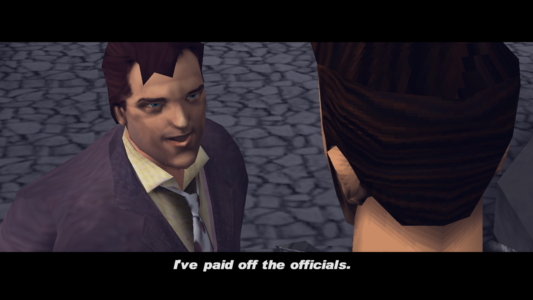
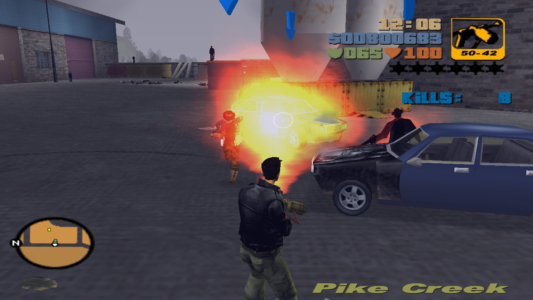
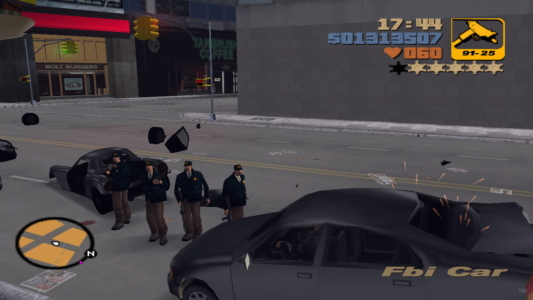

 Posts
Posts
Very nice review, as usual — sorry, congratulations are always much shorter than complaints ! 😉
Aeons ago, found “GTA III” very nice but less satisfying than similar “True Crime : Streets of L.A.”, though : in spite of its “clichés” and minor annoyances, TCSLA’s story development was more linear and more clever than GTA3’s (each ending matching the level of player’s will to dedicate more time to the game). I did finish it, while I did not bother to do so with GTA3.
May 21, 2019 @ 8:36 am
As I said in the review, I also gave up on GTA 3 back in the day but can’t remember why – I guess there are a number of missions which are a big pain to repeat and the younger me lost patience with one of them.
I do have True Crime and the plan is to cover some other similar games of this era, time and motivation allowing…
May 21, 2019 @ 8:43 am
GTA3 and Vice City took up a fair amount of my second year of college. On the Xbox, where you could rip CDs and have the music appear as a radio station in-game. I feel like some of the shine had worn off since it was a year or two (?) after the PS2 release, so it didn’t feel as groundbreaking as I’m sure it did originally.
Also remember True Crime. Thought it would teach me the layout of L.A. in case I ever moved there. Didn’t take long to realize it’s usefulness as an educational tool was going to be extremely limited.
Honorable mention to the remake of NARC. Not a great game, but pretty average for the time.
May 25, 2019 @ 12:32 am
If I remember rightly they did a double pack of those two for Xbox. And they were slightly polished up versions too.
I should perhaps have mentioned that you can play your own music in this version, if you copy some MP3 files to the appropriate folder. My collection is in such a mess, however, in all likelihood I’d end up listening to a cricket podcast while playing, which hardly fits the action.
I never knew you were planning to become an LA detective who doesn’t play by the rules JMan 😀
May 25, 2019 @ 6:32 am
I can neither confirm nor deny that my badge is currently in the chief’s desk drawer, waiting to be reluctantly pulled out again when I present my evidence.
June 10, 2019 @ 7:00 pm
I have lived in my home city for the better part of 25 years now.
I still need Google Maps to find places here.
I can find my way to any spot in GTA3 Liberty City off of memory, even 18 years after the game came out.
I don’t know what this says about me.
June 30, 2019 @ 7:02 am
The same as “Uncle Dave”. I know each street of Mafia’s Lost Heaven by heart (played the game three times), while I can’t remember any location in real towns. I even find landscapes in racing games more interesting than real landscapes (possibly because one sees them in full comfort without any inconvenience such as having to travel). 😉
July 2, 2019 @ 9:41 pm